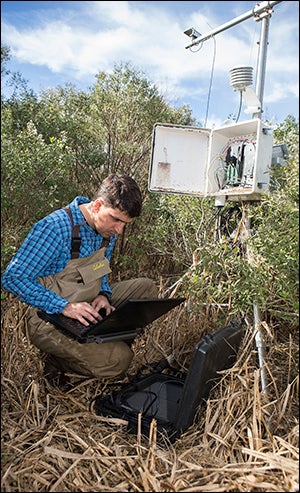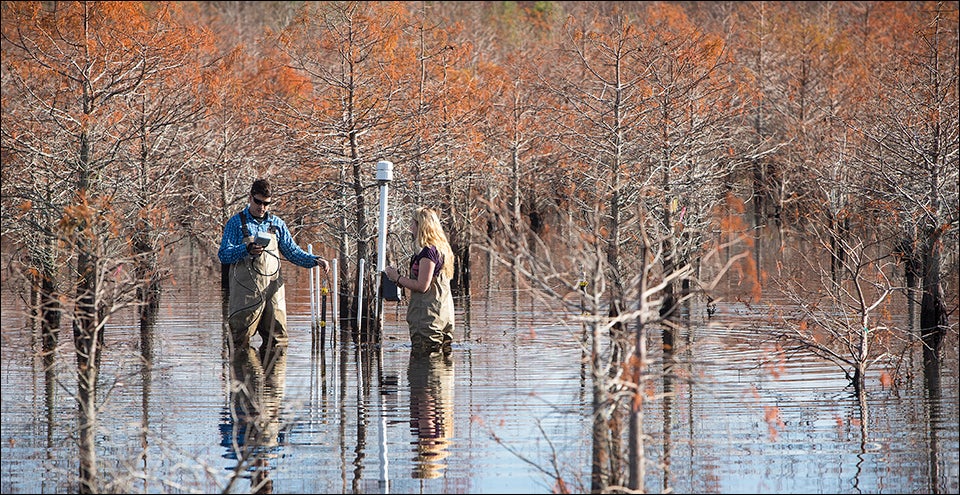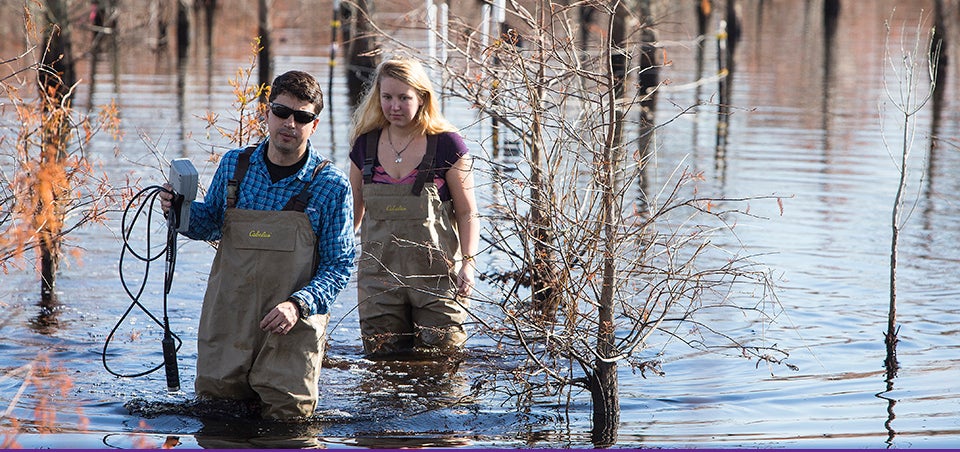‘SALTWATER INTRUSION’
ECU researchers receive funding to study, protect N.C.’s inner banks
A new grant will allow East Carolina University and partner institutions to address a saltwater issue affecting the ecosystems and economy of eastern North Carolina.
Saltwater from the ocean is making its way into freshwater sources along the coastal plain, causing a myriad of problems. But by joining forces with N.C. State University, UNC-Chapel Hill and Duke University, ECU researchers plan to examine these problems through a multidisciplinary lens.
Marcelo Ardón, assistant professor in ECU’s Department of Biology, is the university’s principal investigator for the five-year project. He is overseeing $354,775 of the total $1.5 million awarded by the National Science Foundation’s Coastal Science, Engineering and Education for Sustainability program.

Ardón collects data near Columbia, N.C. as part of the multidisciplinary research on saltwater intrusion.
“Primarily we’re looking to understand the consequences to agriculture and to natural ecosystems when you have increasing salinity in the inner banks,” Ardón said. Their research focuses on the peninsula surrounded by the Albemarle, Pamlico and Croatan sounds.
Researchers already have good projections about the impact of sea level rise in the next 100 years, but this group wants to study exactly what to expect just 10 or 20 years down the road.
“We won’t simply wake up one day and find (the peninsula) permanently inundated by saltwater,” said Ryan Emanuel, the project’s lead investigator and assistant professor of hydrology at N.C. State University.
“Rather, the complex interactions between humans and nature will determine when, where and how saltwater will invade this region over the next several decades.”
This saltwater intrusion – the landward movement of salinity from the coast onto the coastal plain – has major consequences both to the lives of residents in the area and the economy of eastern N.C.; timber companies and agricultural corporations own a majority of land on the sound.
“When you have increasing salinity (in freshwater), it leads to several issues: it causes plant mortality which is very bad for agriculture and it can decrease water quality by causing soils to release too many nutrients,” Ardón said. It’s also a big problem for drinking water, which can be extremely expensive to desalinate, he added.
The project team will study both the natural and human causes of saltwater intrusion, which Ardón explained is most likely to improve or worsen based on how people change their behaviors.
“A lot of it will have to do with the decisions that people make; whether or not to use pump stations (in ditches and canals), whether or not to build more or fewer canals in agricultural fields, when to pump and how much to pump,” he said.
An important piece of the study will be interacting with residents who live in the area. As the social scientist on the project, Todd BenDor, associate professor of city and regional planning at UNC-Chapel Hill, will coordinate these stakeholder meetings.
“Very few assessments of sea level rise really look at how people who own or manage land will actually react to changes in the landscape,” BenDor said. “They take it as a given that landowners will eventually flee the coast as saltwater starts to inundate their properties. However, we know that this process will take time and that in the interim, a lot of efforts will be made to change the way land is managed.”
Working with government and private entities in the region, the team will communicate possible consequences based on their saltwater monitoring data. They are planning to host at least one stakeholder meeting for each year of the grant, where they will share updates in an easy-to-understand and relevant way.
“The first set of workshops is mostly for us to collect information and, at the same time, we’ll be collecting the field data,” said Ardón. “In subsequent years, we’ll present the results and use different scenarios to illustrate what is most likely to occur, and most importantly, give them a toolkit that they can use to make better decisions.”
Also working on the project are Emily Bernhardt and Justin Wright, who are ecologists at Duke University. Ardón is excited to have a diverse group of researchers with various areas of expertise and from different schools.
“It’s pretty unique to have experts from these four large universities working together,” Ardón said. “It doesn’t actually happen that often. So that’s very exciting.”

